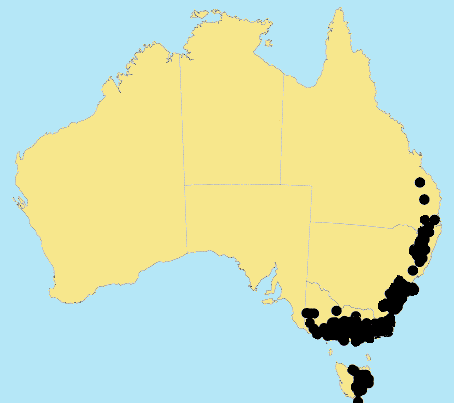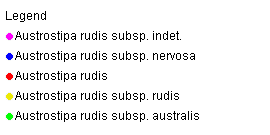Austrostipa rudis (Spreng.) S.W.L.Jacobs
& J.Everett. Telopea 6: 588 (1996).
Classification.
(GPWG 2001) : Subfamily Pooideae. Tribe Stipeae.
Basionym and/or
Replacement Name: Stipa rudis Spreng.,
4: Cur. Post. 31 (1827).
Type of Basionym or
Protologue Information: HT: Sieber 66, Australia (?; IT: K,
MEL59980, MEL-59982).
Key references
(books and floras): [2002] D.Sharp & B.K.Simon, AusGrass, Grasses of
Australia, [2008] S.W.L.Jacobs, R.D.B.Walley & D.J.B.Wheeler, Grasses
of New South Wales (158), [2009] A.Wilson (ed.). Flora of Australia,
Vol 44A. Poaceae 2 (38 as subsp. rudis, subsp. australis,
39 as subsp. nervosa).
Illustrations:
[2008] S.W.L.Jacobs, R.D.B.Whalley & D.J.B.Wheeler, Grasses of New South
Wales, 4th edn (158).
Habit.
Perennial. Rhizomes absent or present, short. Culms geniculately ascending,
60–120 cm tall, 2–4 mm diam., firm, 2–4 -noded. Mid-culm internodes pubescent.
Mid-culm nodes pubescent. Lateral branches simple. Leaf-sheaths glabrous on
surface or hairy. Ligule a fringed membrane, a ciliolate membrane, 0.5–2 mm
long, scarious, abaxially hairy, truncate or acute. Leaf-blades erect, involute
or convolute, 20–40 cm long, 2–5 mm wide. Leaf-blade surface scaberulous,
indumented.
Inflorescence.
Inflorescence compound, a panicle or a panicle. Panicle linear, 25–50 cm long,
1.5–5 cm wide.
Spikelets.
Spikelets pedicelled. Fertile spikelets 1-flowered, comprising 1 fertile
floret(s), without rachilla extension, linear, terete, 8–15 mm long.
Glumes.
Glumes similar, thinner than fertile lemma. Lower glume linear or oblong,
membranous, without keels, 3 -nerved. Lower glume surface glabrous or
indumented. Upper glume linear or oblong, 7–14.5 mm long, membranous, without
keels, 3–5 -nerved. Upper glume surface asperulous, glabrous or indumented.
Upper glume apex erose.
Florets.
Fertile lemma 5–11.5 mm long, without keel, 5 -nerved. Lemma surface
indumented. Lemma apex entire or lobed, awned, 1 -awned. Median (principal) awn
20–90 mm long overall, with a twisted column. Column 4.5–45 mm long. Palea 2
-nerved, without keels. Lodicules present. Anthers 3. Grain 3–6 mm long.
Continental
Distribution: Australasia.
Australian
Distribution: Queensland, New South Wales, Victoria, Tasmania.
Queensland:
Burnett, Darling Downs, Moreton. New South Wales: Central Coast, South
Coast, Northern Tablelands, Central Tablelands, Southern Tablelands,
North-Western Slopes. Victoria: East Gippsland, Eastern Highlands,
Gippsland Plain, Midlands, Otway Range, Volcanic Plain, Wannon. Tasmania:
North West, Central Highlands, Midlands, Ben Lomond, East Coast.
Notes. Three
subspecies are recognised, following J.Everett & S.W.L.Jacobs, Telopea
2: 395 (1983).
A widespread species of higher areas in eastern Australia,
from south-eastern Queensland to Tasmania.
subsp. rudis
On sandstone
in higher areas of south-eastern Queensland and eastern New South Wales and
Victoria.
subsp. australis
Sandstone in
higher areas of eastern Victoria, and Tasmania.
subsp. nervosa
Sandstone in
higher areas of south-eastern Queensland, eastern New South Wales and Victoria.
.
Infra -specific
taxa: subsp. australis, subsp. rudis, subsp. nervosa.
Awn 60–90 mm long with
column 32–45 mm long A. rudis subsp. australis
Awn less than 60 mm
long with column to 25 mm long
Column 20–25 mm long;
callus 1.5–2.5 mm long A. rudis subsp. rudis
Column less than 20 mm long; callus 0.8–1.7 mm long A. rudis subsp. nervosa





